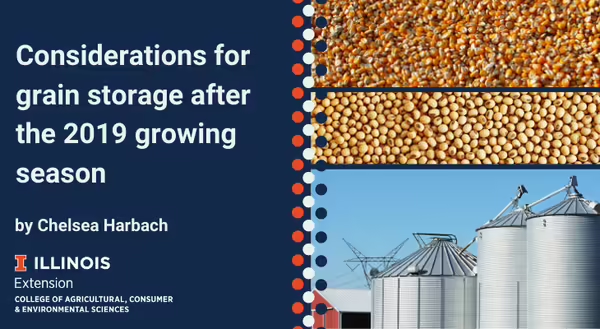
Needless to say, we have had an extremely atypical growing season in 2019. A prolonged planting window due to relentless rains, with many fields not planted until June, have resulted in many higher-than-average grain moisture levels at harvest. Observing elevated harvest moisture on a widespread basis throughout Illinois can have some inadvertent ramifications for grain storage. Please consider this following hypothetical chain of events:
- Harvest moisture in grain is consistently about 10% higher than the average harvest moisture in a typical year.
- More time and fuel must go into ensuring that the grain is dried down to a suitable level for storage. (no more than 13.5% for corn and 12.5% for soybean).
- Mechanical drying makes grain more brittle and susceptible to breaking, introducing more fines into the stored grain. (Fines are materials smaller than whole corn kernels, in this instance used to describe portions of the grain breaking off due to brittleness of the grain)
- Fines in the grain can inhibit the flow of air when running an aerator to help maintain consistent and uniform grain temperature and moisture in storage.
- Pockets of the stored grain blocked from aeration by fines may end up becoming too moist or warm, opening opportunities for the activity of storage molds in the grain.
- Once pockets of infected grain begin, the warmth spreads through the stored grain and the pocket gets larger and warmer. More and more grain is spoiled.
This undesirable series of events could add more insult to injury after an already painful year. That is why monitoring stored grain this year will be critical to maintaining the quality and subsequent return on the grain.
One of the first things you can do to prevent grain spoilage this fall is to make sure that you are not cutting corners when drying down the grain before storage. While mechanical drying can increase the fines within the grain, it will be easier to manage and monitor stored grain with fines than to hope that grain stored with elevated moisture levels won’t spoil.
A second thing to consider in avoiding storage mold problems this year is to try to keep the top surface of the grain in your bins as level as possible (i.e. get rid mounded grain). Mounded grain will be more likely to spoil because it will not be evenly aerated with the rest of the grain below it. But be sure to take proper safety precautions when working in and around the bins.
And finally, I encourage you to not skip on monitoring stored grain this winter. General recommendations are to check the stored grain every two weeks in the winter. This recommendation may be occasionally overlooked by farmers depending on the year. However, this is not a year to be stingy with the grain bin monitoring. Things you are looking for include condensation in the bin, crusty-looking, wet, or frozen grain, warm spots, and bad, moldy odors.
For more information on monitoring stored grain, refer to this resource from Purdue Extension (scroll down to the “Observation and Management of Stored Grain” section. This article also includes a list of problems you might encounter in stored grain and recommended solutions for the problem.